You can trust Coach
As a runner I’ve always envied the wealth of indoor training options that cyclists have. For one thing a good-quality exercise bike (or turbo trainer you can ride your bike on) is cheaper and smaller than a treadmill, making it a more accessible domestic cardio option. For another, there are a lot more entertainment options for indoor cyclists, if only because it’s easier to watch TV when sitting on a bike than using a treadmill.
Virtual training app Zwift is one of the best options cyclists have for making indoor training more exciting – and although Zwift caters to runners as well, the point about affording a treadmill fitting in your house still stands.
To use Zwift you connect a smart turbo trainer or exercise bike to the app, and it’s this that controls your avatar, which rides in a virtual world. The main Zwift world is called Watopia, an island with underwater tunnels, snow-capped mountains, a desert and a volcano, among other environments. Alongside Watopia you have access to cycle routes in London, New York and select World Championships courses in Yorkshire, Innsbruck and Virginia, with one of these guest worlds available each day.

Zwift will automatically control a smart trainer to simulate the hills your avatar is riding on, creating a very realistic and immersive experience that’s absolutely if you want to keep riding for cyclists looking to train through the winter to prepare for their outdoor rides when the weather gets warmer.
Zwift’s appeal to cyclists is obvious, but what about the average person who’s just looking to get fit? Since Zwift is relatively cheap to set up (costs are detailed below) and allows you to train at home in a convenient way that’s also more exciting than simply sitting on an exercise bike or rower, I thought it could be a great option.
After a few months of riding on the platform, I think Zwift would suit some people perfectly as a get-fit-at-home option – but the heavy, and understandable, skew towards keen cyclists can be a little off-putting for others. If you don’t get sucked into the world of cycling, indoors and out, you may struggle to find the motivation to keep at it.
The Set Up
I’m going to go ahead and assume you already have a bike (ideally a road bike, although a hybrid will probably suffice – check before investing). If you don’t, factor that price into your initial budget. If you do, you can choose between a cheaper wheel-on turbo trainer and a pricier direct drive trainer, where you remove your back wheel and attach your bike directly to the trainer. This creates a more realistic feel to your ride and stops you wearing out your back tyre cycling indoors.
A smart trainer will automatically communicate with Zwift to add resistance when you’re climbing hills in Watopia, and let you freewheel down hills, which really enriches the experience. You can opt for a cheap turbo and then buy sensors that will provide Zwift with your power and speed/cadence in the app, but it’s far more enjoyable with a smart trainer and I’d say it’s worth the extra outlay if your budget can stretch that far.
For the purpose of this review Zwift provided me with an Elite Direto smart direct drive trainer, which is usually available for around £500 to £650 online. That took care of all the required cycling sensors, and I already had a chest strap heart rate monitor I could link to the app once I bought a cheap ANT+ dongle for my laptop.
The trainer and bike are the key bits of kit, but I also put an old TV in my garage to link to my laptop, because the bigger the screen you play Zwift on, the more immersive it is. It’s also worth having a mat under the trainer and a fan, because indoor riding is about as sweaty an activity as there is.
The Zwift subscription itself costs £12.99 a month. You can set everything up for less with a standard smart turbo, which will set you back something in the region of £200 to £300.
If you don’t have a bike, or don’t want to attach your bike to a trainer, you can opt for a smart exercise bike like the Wattbike Atom for Zwift. This will set you back a lot of money, however, at £1,599.
Once I had all the gear, it took about 30 to 40 minutes to get my bike rigged up. I’d not used a direct drive turbo before and am not what you’d call handy, so most people would probably get this done more quickly. Most people probably wouldn’t have drawn blood from their hand in two places during the process either… Anyway, after that mild palaver, it was time to ride.
See related
- How To Get Fit At Home
- How To Get Started With Zwift Running
- The Beginner’s Guide To Turbo Training
- The Best Turbo Trainers 2021: Which Direct Drive, Magnetic And Smart Indoor Trainers Are Worth Buying
- Savage Turbo Trainer Workouts From Pro Cyclists
The Experience
I was not expecting Zwift to be as fun as it is. I like being outdoors, but cycling outdoors in London isn’t always that enjoyable for the obvious reasons. The best part of riding in Watopia is that you can cycle at whatever speed you like safely.
Easy rides on Zwift are a joy, pootling along admiring the virtual landscape. That’s especially the case early on when you’re exploring the different areas of Watopia and the other worlds. I was using Zwift for one to three 30-minute sessions a week, and at that slow pace it takes a while to explore all the routes, though you could see everything a lot quicker if you knocked out two or three 50km rides.
Throughout the Zwift worlds there are little mini challenges, like a King of the Mountains segment up a climb or a sprint on a flat section. These add a little spice to rides, because even if I was on an easy cycle I’d feel compelled to put in some effort for those short sections.
If you choose a particular route on the start screen you don’t have to do anything to navigate around while riding, but if you want to explore the map on your own terms the best way to do so is with the Zwift companion app. This allows you to make turns when you come across them and shows where you are on the map.
One feature I didn’t expect was that you have to level up on Zwift to be able to visit every area of Watopia whenever you want to. Certain routes, including the daunting but exciting Alpe Du Zwift, a 1,036m climb that recreates the famous Alpe d’Huez, remains locked to me until I have hit level 12 yet. It takes a while to progress through the levels when only using Zwift for short rides a couple of times a week, because you earn points through distance covered. You can, however, reach the locked areas of the map if you enter group rides, workouts and races, or if you ride with a more experienced Zwift user who has hit the required level.
Group events are a key part of Zwift and there are a lot to join every day at times to suit every rider. There is also a range of rides to suit all abilities, with each having an advertised category from A to E. The letters correspond to your functional threshold power in watts per kilo, which is complicated, but basically E is the easiest and once you’re in a group pride you’ll be expected to stay in a certain power range so you stick with the group. You can see your watts per kilo rating onscreen at all times, so there’s no excuse for not staying in the right zone, and if you fail to do so repeatedly you’ll be kicked out of the group ride (after many warnings).

There are also lots of workouts and training plans that you can follow on-demand on Zwift. There are long and short workouts, and plans designed to help you work towards cycling events, or improve a particular aspect of your cycling. All of the workouts are designed around your functional threshold power (FTP), which Zwift will detect automatically while you pedal, but it’s best to do a proper FTP test on the app before you start on the workouts to make sure they’re tailored correctly to your ability. The FTP test is fairly brutal, be warned.
If any or all of the above sounds quite jargon-heavy, it did to me too. This is one downside of using Zwift just to get fit: it’s all aimed at cyclists so things like FTP are central to everything, and all the workouts and plans are built to help you nail cycling events rather than just, say, burn a load of calories. The interval workouts will have the same effect as doing a HIIT class with a peppy, charismatic instructor on a luxury Peloton spinning bike, but on Zwift it’s all couched in cycling terms that take a little while to get used to. Over time you might well get dragged into the world of cycling and start considering entering outdoor events, but if you’re purely using Zwift as a way to log your 150 minutes of cardio activity a week, the jargon might be a bit off-putting.
However, Zwift is still a brilliant option for people trying to get fit at home, and it will probably appeal to a different kind of person than something like Peloton. If you love being out in the open air when possible, actually cycling in a virtual world will appeal more than indoor spinning sessions, as odd as that might sound since you are still indoors. Simply riding around Watopia is tremendously enjoyable, moving from the desert to the forest and then up a mountain in the space of one ride, and if you can get a TV rigged up to play it on, it’s highly immersive.
A large upfront investment is required, but it’s a lot cheaper than Peloton (bike £1,990, monthly unlimited classes £39) and will even out with a gym membership after a few months (or years if you use a budget gym). The ongoing cost of Zwift is also low, and with an indoor trainer you’re not tied just to the Zwift platform – there are others like TrainerRoad to explore, and you can try spinning classes from other apps too.
There is one other question that you might well ask – why not just ride a bike outdoors? And of course you can, but when the weather is bad, or you want to do a hard workout in a short space of time, or you’re housebound for whatever reason, or when you just fancy riding without having to worry about other road users at all times, there’s Zwift, and it’s excellent.
Join Zwift | £12.99 a month

Nick Harris-Fry is a journalist who has been covering health and fitness since 2015. Nick is an avid runner, covering 70-110km a week, which gives him ample opportunity to test a wide range of running shoes and running gear. He is also the chief tester for fitness trackers and running watches, treadmills and exercise bikes, and workout headphones.

“My Absolute Favorite Thing That I Do With All Of My Athletes”—Finish Your Next Workout With This NASM Trainer’s Leg Circuit

CrossFit Quarterfinals Explained—What You Need To Know Before The 2024 Competition Begins

This Beginner Arm Workout Is A Simple And Effective Way To Start Building Muscle With Dumbbells
